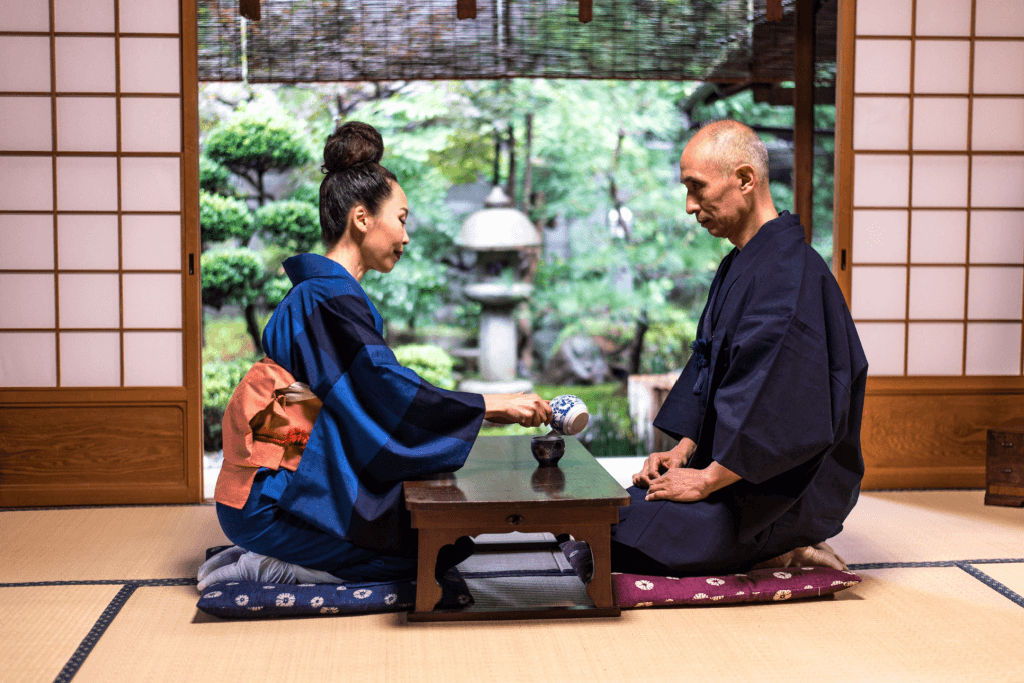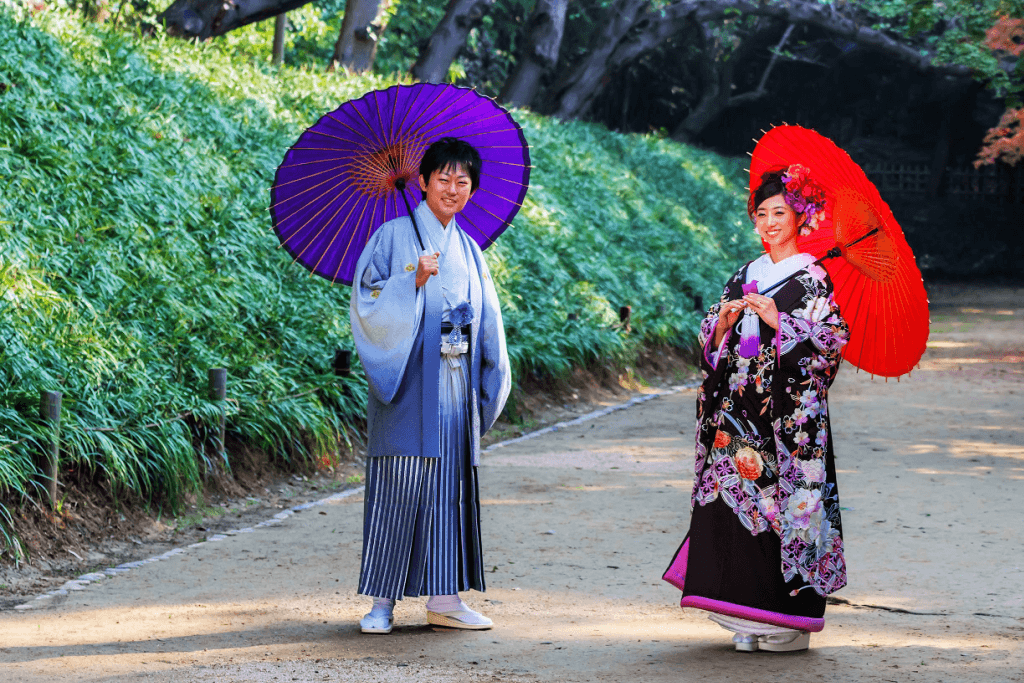kimono, traditional japanese clothing
Men’s Kimono: Captivating the World with its Classic Appeal and Versatility
James Lau
Posted on June 09, 2023
Share:

Kimono, the traditional Japanese garment, has captivated the world with its elegance, intricate craftsmanship, and rich cultural heritage. While often associated with women’s fashion, men’s kimono offers a unique and distinguished style that has gained popularity globally.
What is Kimono?
Kimono, derived from the Japanese word “kiru” (to wear) and “mono” (thing), refers to a full-length robe worn as a traditional garment in Japan. Furthermore, they are famous for their graceful silhouettes, wide sleeves, and striking patterns. Initially, the kimono was a universal attire for both men and women. Nevertheless, distinct styles and designs emerged to differentiate between genders over time.

Differences between Women’s and Men’s Kimono
Structure and Silhouette
Generally, women’s kimono are typically more fitted and tapered at the waist, emphasizing the feminine figure. Additionally, they often feature an hourglass shape and may have an adjustable inner belt known as an obi-jime to secure the garment. Women’s kimono also tend to have longer sleeves, allowing graceful movements.
In contrast, a men’s kimono has a straight, rectangular shape devoid of waist definition. The silhouette is looser and more relaxed, reflecting a more casual and understated aesthetic. Moreover, their sleeves are generally shorter and narrower compared to women’s kimono.

Colors and Patterns
Women’s kimono embraces a wide range of vibrant colors and intricate patterns. The palette includes bold shades such as red, pink, purple, and bright pastels. Traditional motifs often found on women’s kimono include cherry blossoms, peonies, cranes, and geometric designs.
Conversely, men’s kimono tend to feature more subdued colors, often opting for darker shades such as navy blue, gray, brown, or black. Not to mention, the patterns on men’s kimono are generally more straightforward and less elaborate, with motifs such as stripes, subtle florals, and geometric shapes.
Accessories and Obi
By and large, women’s kimono use a wide range of accessories, including multiple layers of undergarments, an obi (wide belt), obijime (decorative cord), and oblige (scarf-like accessory). Therefore, an obi is a prominent feature of women’s kimono and is intricately tied in various styles, adding flair to the ensemble.

On the other hand, men’s kimono typically have a more straightforward and narrower obi, known as a koshihimo, used to secure the garment. In addition, they usually require fewer layers or accessories than women, reflecting a more minimalistic approach.
Would you like to experience traditional Japanese culture like kimono? Try Sakuraco! Sakuraco sends traditional Japanese snacks, teas, sweets, and kitchenware so that you can taste Japanese culture right into your home!
Haori and Hakama
In men’s kimono fashion, the styles and designs extend beyond the kimono itself, encompassing the versatile components of haori jackets and hakama trousers. The haori jackets, whether adorned with intricate patterns, family crests (kamon), or other decorative elements, offer a magnetic layer of sophistication and formality to the ensemble. They come in various styles, from formal to casual. Sometimes people customize it for individual tastes.

On the other hand, hakama trousers also bring a sense of elegance and tradition with their pleated construction and wide-legged silhouette. Therefore, the distinct hakama pleats create an aesthetic balance and fluid movement. In addition, the haori jackets and hakama trousers elevate the overall style of men’s kimono, adding layers, texture, and a touch of formality, while allowing for innovative combinations and unique expressions of personal style.
Interesting Styles and Designs for Men’s Kimono
Komon
Komon refers to a casual style of men’s kimono with small, repeating patterns throughout the fabric. More specifically, these patterns can include delicate florals, geometric motifs, or nature-inspired designs. Komon kimono are versatile and suitable for everyday wear or informal gatherings.
Iromuji
Generally, iromuji is a single-colored kimono style that exudes simplicity and elegance. These kimono are for formal occasions such as weddings, tea ceremonies, or formal events. Iromuji kimono can be made from silk or other high-quality fabrics and may feature subtle woven patterns or embroidered designs to add visual interest to the solid color.

Montsuki and Kurotomesode
Montsuki kimono has family crests (kamon) prominently on the chest, back, and shoulders. Generally, these crests represent the wearer’s lineage or affiliation and can vary in design and number depending on the social status or occasion.
Kurotomesode is a formal kimono worn by married men on special occasions. These black kimonos feature five family crests strategically placed around the garment. Kurotomesode and montsuki kimono are suitable for significant events such as weddings of close family members or formal gatherings.
Modern-Day Trends for Men’s Kimono
The world of men’s kimono continues to evolve, blending traditional elements with modern sensibilities. Here are some exciting trends that have gained momentum recently!
Fusion of Traditional and Modern Elements
Contemporary men’s kimono designs often blend traditional elements with modern aesthetics. These styles use unconventional fabrics like denim or linen and experiment with bolder colors or patterns. Using traditional craftsmanship and contemporary design creates unique and stylish kimono ensembles.
Simplified Silhouettes
While traditional men’s kimono typically have a loose and relaxed silhouette, modern trends have preferred more streamlined and fitted styles. Slimmer sleeves and narrower cuts create a sleek and modern look while maintaining the kimono’s essence. As a result, this approach allows for easier integration with everyday fashion and broader appeal.

Unique Fabric Combinations
Men’s kimono designers experiment with various fabric combinations to create visually striking and textured garments. They combine different silk, cotton, and linen types and even incorporate unconventional materials such as leather or synthetic fabrics. These unique fabric combinations add depth and visual interest to the kimono.
Contemporary Patterns and Motifs
Overall, modern men’s kimono designs often feature contemporary patterns and motifs, departing from traditional motifs like family crests. Geometric shapes, abstract designs, or bold graphics appeal to younger generations and those seeking a more fashion-forward approach to kimono styling.
Layering and Styling:
Contemporary men’s kimono fashion embraces layering and experimentation with different garments and accessories. This style specifically includes pairing the kimono with contrasting colors, adding haori jackets or vests, and accessorizing with belts, scarves, or statement jewelry, many of which are available at secondhand stores. The versatility of men’s kimono allows for creative styling. As a result, individuals can undoubtedly express their style while staying true to the kimono’s essence.
Revival of Vintage Kimono
Surprisingly, there is a growing interest in vintage kimono styles and fabrics, particularly among fashion enthusiasts who appreciate older pieces’ historical significance and craftsmanship. Additionally, vintage kimono, with their intricate patterns and unique textures, are incorporated into modern looks, creating a blend of retro and contemporary fashion.
Global Influences
Presently, global trends and cultural exchanges also influence men’s kimono fashion. International collaborations, reinterpretations of traditional garments from other cultures, and the fusion of East-meets-West aesthetics are becoming more prevalent. For the same reason, these global influences add a contemporary and cosmopolitan touch to men’s kimono fashion.
In the ever-evolving world of men’s kimono fashion, blending traditional aesthetics with contemporary design sensibilities has created a new era of creativity and individual expression. From streamlined silhouettes to unconventional fabric choices, the current trends reflect a desire to honor the cultural heritage of the kimono while embracing modernity.

With a focus on unique patterns, layering techniques, and global influences, men’s kimono fashion allows individuals to weave their own stories and make a bold statement in today’s diverse and interconnected world.
Whether honoring tradition or pushing the boundaries of innovation, men’s kimono continues to captivate and inspire with its timeless elegance and enduring appeal! Have you ever worn a men’s kimono? How was your experience? Let us know in the comments below!

Discover authentic flavors with Sakuraco
Get Sakuraco 

Discover authentic flavors with Sakuraco
Get Sakuraco 
Related Articles

Steam Train in Shizuoka: Riding the Oigawa Railway
For travelers who love history, beautiful views, and cozy retro vibes, this steam train is one of Shizuoka’s most charming treasures, with some of the best views. If you want to know more about this train, keep reading below!

Nara Japan: The Amazing Legend of the Sacred Dragon
In Japanese culture, dragons are spiritual beings that represent strength, prosperity, and a harmonious balance with the natural forces. Nara, Japan, has a unique story associated with sacred ponds and revered shrines throughout the region.

Nambu Tekki: Morioka’s Amazing Iron Craft
In the historic city of Morioka, Iwate Prefecture, a craft with over 400 years of history continues to captivate with its rustic beauty and practical charm. Nambu tekki, or Nambu cast iron, refers to traditional ironware, such as teapots, kettles, and decorative pieces, that embody the spirit of Tohoku craftsmanship.

Ebisu: The Cheerful Guardian of Luck and Prosperity
Religion in Japan involves a dizzying array of spirits and beings. These gods are inspired by ancient tales and used to symbolize nature’s bounty. However, they also profoundly impact daily life and are often sought out for help in challenging times



